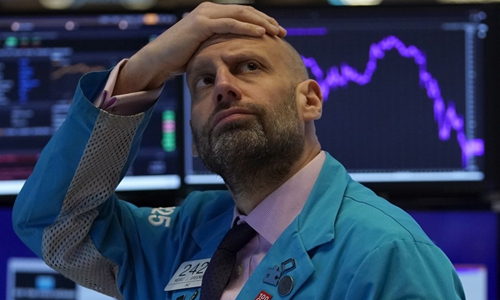HOME >> SOURCE
Is it about time to pounce upon the global stock massacre?
Source:Global Times Published: 2020/3/23 21:11:57

Meric Greenbaum, Designated Market Maker IMC financial looks up at the board before the opening bell right before trading halted on the New York Stock Exchange on March 9, 2020 in New York. Photo: AFP
A coronavirus-induced panic among global investors is still showing no signs of fundamental easing, with a recovery staged by stock markets in some trading days proven only a respite from a downward spiral that has erased a staggering amount from global equity valuations.
The US stock market that has long taken pride in its years-long bull run has abruptly turned out to be a slaughterhouse, with a trading halt in US stocks on March 18 marking the fourth time within 10 days circuit breakers were tripped for the market. Frequent trading halts in US stocks and stock futures have put investors across the globe on edge.
Even Chinese mainland shares that have better fared the latest round of global market rout have now been mired in a risk-off sentiment, with the two Shenzhen indices having shed over 11 percent this month as of Monday's close. Some semiconductor shares, among a host of preferred stocks, have lost 20-30 percent this month.
The substantial fall in US shares at large and in some mainland stocks has understandably prompted one to ask: Should we buy the dip now? The answer would regrettably be no for the time being.
Although it makes sense that the latest round of severe sell-off is incubating a golden buying opportunity for good stocks, a rush into the market in anticipation of a quick, lucrative rebound seems highly risky. It's often the case that history repeats itself on Wall Street, but it could well be the case that it would take a long while for a pounce on discounted stocks to bear fruit. With no imminent signs of the global stock selloff grinding to a halt, it's not worth the risk to buy the dip now. That's supposed to be the mantra of investing recommended for retail investors in the mainland market in particular.
The benchmark Shanghai Composite Index is now at levels not seen since February 2019 and is on pace to trend down further to its lows in January 2019, roughly 20 percent down from its year-to-date high of 3,100-plus points in January, if external shocks from the coronavirus pandemic continue.
In addressing a dollar funding squeeze that has precipitated panic selling of both risky assets and safe haven assets, the Federal Reserve has announced an emergency rate cut by a full percentage point and launched a massive quantitative easing program. Unprecedented relief packages are also being sought to pour liquidity into the market.
But why have a slew of measures failed to calm the markets? The worryingly fast spread of the coronavirus pandemic in the US and Europe surely has added to nervousness, as a turning point in the disease is still at least some time away.
What's also culpable is Fed policy ineffectiveness. The emergency announcement that took the global markets unprepared had compounded the stock bloodbath that was induced by the virus outbreak but was more worryingly fueled by the dollar liquidity crunch that initially set in around 2019 when the Fed took an abrupt turn in its monetary policy.
The worse-than-expected liquidity squeeze has pushed the US dollar index into a multi-year high, with major non-US currencies under sustainably pressure to devalue. It's not only about the stock market crash now, but about a selloff ranging from stocks to gold to non US-currencies.
Net outflows via the northbound trading links between Hong Kong and mainland bourses that have largely continued since March 11 indicate the continuity of liquidity crunch.
Not until signs of a reversal emerge shouldn't we consider buying the dip.
Posted in: ECONOMY